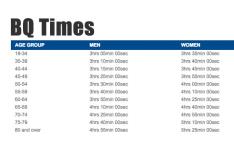Weeks 1-2-3
Sunday: Runs of 11 miles (week 1); 13 miles (week 2); 15 miles (week 3); with moderate 1-minute surges every 8 to 9 minutes over the final 6 miles
Monday: Recovery day (off/rest) with 45 to 50 minutes of non-running, low impact exercise (weeks 1, 2, 3)
Tuesday: Relaxed 5 miles (week 1); 7 miles (weeks 2 and 3)
Wednesday: 6-7 miles (weeks 1, 2 and 3) with three moderate 1-mile surges beginning after 2 miles (target 10 to 15 seconds per mile faster than goal marathon pace) each with a half-mile walk/jog between them.
Thursday: Recovery/walk 60 to 70 min (weeks 1, 2 and 3)
Friday: Short run (3 miles week 1; 4 miles weeks 2 and 3)
Saturday: Short run of 3-4 miles, or 45 to 50-minute non-run exercises (weeks 1, 2) and 4-mile run (week 3)
Weeks 4-5-6
Sunday: 9-10 miles (planned pull-back week 4), 16 miles (week 5), 17 miles (week 6). Weeks 5 and 6 alternate 1- and 2-minute surges every 8 to 9 minutes over the final 8 to 9 miles moderately
Monday: Recovery, non-running exercise up to 60-65 minutes (weeks 4, 5, 6)
Tuesday: Relaxed 4 miles (week 4 is a pull-back week); relaxed 6 miles (weeks 5, 6)
Wednesday: 5 miles, easily (pull-back week 4); 7+ miles with workout of six to seven 800m at approximately 15 to 20 sec per-mile faster than goal marathon pace. Integrate a 2-minute recovery walk between each 800. Don’t forget a 2-mile warm up and 1-mile cool down (weeks 5, 6)
Thursday: Walk 75 minutes (weeks 4, 5 and 6)
Friday: Shorter run of 4 miles (planned pull-back week 4); 6 miles (weeks 5, 6)
Saturday: Off day (planned pull-back week 4); 5 miles (weeks 5, 6)
Weeks 7-8-9
This is the final push preceding the taper. This 3-week stretch will include two marathon-specific long runs within which you should be practicing fluid and fuel intake, as well as making your long runs similar to the topography of your target race.
Week 7
Week 7 has a long run in play as well as some moderate work to begin improving tempo-based strength. Accelerations as well as the long run surges will improve economy. For improved aerobic conditioning, there is the option for a couple of additional non-running workouts, such as deep water pool running or swimming.
Sunday: Long run, 18-20 miles, with the final 8 to 9 miles moderate. In addition, throw in a 1-minute pick-up every 7 to 8 minutes over the final 80 of the run. Conclude run with six 100m strides for economy
Monday: Non-run day (rest); optional non-running exercise (swimming or pool running)
Tuesday: Easy 6 miles, conversational pace
Wednesday: 7-8 miles, with 10-12 moderate 3-minute pick-ups (think 10K/half marathon effort) with 2-minute easy jog between each pick-up in the middle of the run
Thursday: Repeat Tuesday miles, relaxed running (optional non-run workout as a second session)
Friday: 6-mile run, pace dictated by how you feel; finish with six 100m accelerations
Week 8
Sunday: Long run, 14 miles easy, with moderate 1-minute surges every 10 minutes over the last 90 minutes. Pick-ups should be assertive but relaxed. Conclude run with six 100m strides for economy. Be sure to practice fluid and energy intake during your long runs. Take 6 to 8 ounces of fluid every 30 to 35 minutes, and ideally 100 to 120 calories of energy intake within the same period.
Monday: Non-run day (rest); optional non-running aerobic exercise
Tuesday: Easy 5 to 6 miles, finish with eight 100m, post-run
Wednesday: After proper warm-up, run an opening piece of 22 to 24 minutes at roughly 15 to 20 seconds per mile slower than your current 10K race fitness. After this opening piece, take a 5-minute slow recovery jog and then run another piece of 14 to 16 minutes at the same targeted pace as the 22 to 24.
Thursday: Short run, 3 to 4 miles (optional non-run workout) or off day
Friday: 8-mile run, pace dictated by how you feel; finish with ten 200m accelerations on the track or on a flat bike path stretch.
Saturday: Off
Week 9
Sunday: Run a half marathon race where the target is goal marathon pace. Be certain to be practicing fluid and energy intake during your long runs. Take 6-8 ounces of fluid every 30 to 35 minutes and ideally 100 to 120 calories of energy intake within the same period.
Monday: Non-run day (rest); optional non-running aerobic exercise
Tuesday: Easy 5 to 6 miles, with eight 100m to finish post-run
Wednesday: After proper warm-up, run an opening piece of 35 minutes at roughly 15 to 20 seconds per mile slower than your current 10K race fitness. After this opening piece, take a 5-minute slow recovery jog and then run six to seven 3-3:30 intervals at 10K effort, with equivalent rest walking between
Thursday: Short run, 4 miles
Friday: 8 to 9 miles, just time on feet at an easy pace (finish with eight 20-second uphills post-run)
Saturday: Rest day
- 2
- of
- 3
About the Author

Get ACTIVE on the Go


Couch to 5K®
The best way to get new runners off the couch and across the finish line of their first 5K.
Available for iOS | Android







Discuss This Article